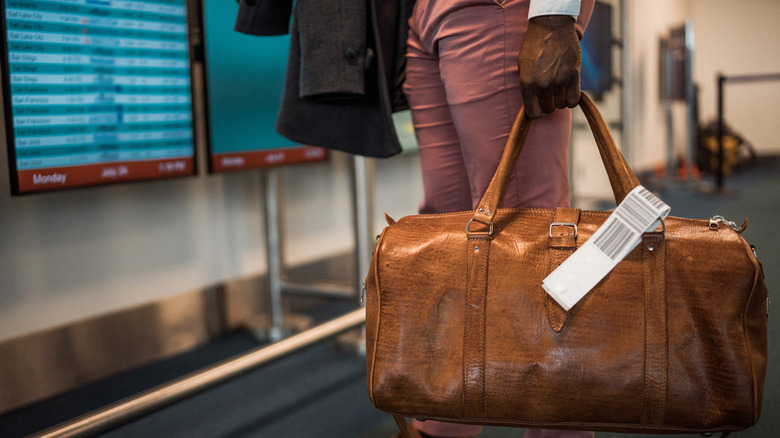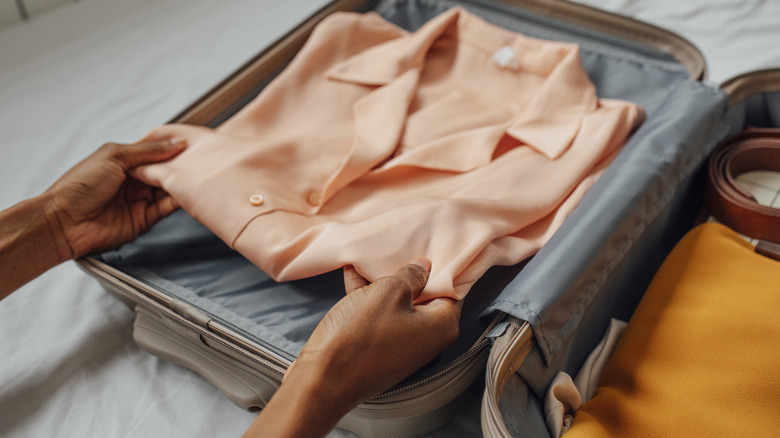
You're all set to fly to a foreign locale for that important business meeting or destination wedding — the tickets are booked and the bags are packed following the 54321 rule. You've also got that stunner of a dress or sharp suit ironed and ready to go in your travel garment bag. There's just one pesky question that remains unresolved: Is this bag a carry-on or a personal item?
If you guessed that it would count as a personal item, you'd be in the majority — it makes sense, as a garment bag is typically
much smaller and lighter than the maximum size restriction of a carry-on (anywhere from 15 to 40 pounds). But in fact, you'd be wrong: All U.S.-based airlines and many international ones consider a garment bag to be a carry-on. Additionally, the size of the bag doesn't seem to matter — it's still a carry-on even if it's as small as a purse. This means that if you were planning on bringing a camera bag, daypack, or laptop case, you'd unfortunately only be allowed to take that item and your garment bag with you on the plane.
The information can be a bit murky, as each carrier has its own regulations. Some airlines make no mention of garment bags at all, while others don't clearly specify their policy. It's always best to check the restrictions for your specific carrier to avoid those never-ending airline baggage fees — and keep in mind that they may differ depending on which class of ticket you've purchased. However, if you can't find the airline's policy or if the terms are confusing, your best bet is to assume you won't be able to travel with an additional carry-on and plan accordingly.
Read more: How To Pack Just One Carry-On For A Week-Long Vacation
Additional Tips For Flying With A Garment Bag

It's worth nothing that baggage rules aren't always strictly enforced. Security may not be particularly concerned, as long as you haven't disregarded the weight and size restrictions — one of those rookie first-time flier mistakes. Additionally, some airline staff aren't even aware of the rules themselves. However, know that if you choose to come with both a carry-on and garment bag, you're taking a risk, and you may be asked to check the latter. Assuming you and your bag make it onto the plane with no issues, place the bag on top of all other luggage in the overhead compartment (or, ideally, hang the item in the closet, if available). You could also purchase a garment bag that doubles as a carry-on, with separate compartments for your necessities.
If you do need to put the item into checked baggage, a hard-shell suitcase is preferable and will better protect your clothing. When folding, align any creases, add tissue between them, layer it with other delicate garments, and wrap it in plastic. These strategies will help to minimize wrinkles and maintain the item's shape. Ensure that your hotel has a steamer, too (steam from a hot shower will also work in a pinch).
Another option is to actually wear the piece of clothing on your flight. This might seem counterintuitive, and it may not be practical if the garment you're transporting is a ball gown for a lavish gala. But wearing a simple suit on a short-haul flight should almost guarantee a wrinkle-free arrival, as long as you're not planning to roll around frenetically in the aisles — an activity that's discouraged by most airlines. Just be mindful of what you eat, as wrinkles will be easier to remove than blobs of ketchup or mayonnaise.
Ready to discover more hidden gems and expert travel tips? Subscribe to our free newsletter for access to the world's best-kept travel secrets.
Read the original article on Islands.











